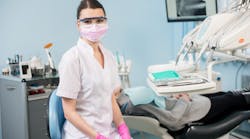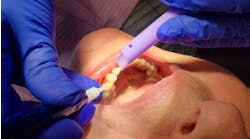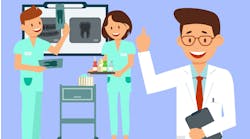There is an abundance of information available to us regarding the topic of musculoskeletal disorders and dental hygienists. The most frequent disorders discussed involve the shoulders, neck, back, hands, and wrists, with a focus on prevention and therapy. But what about our eyes—the "other half" of hand-eye coordination that makes our jobs possible? The care of our eyes—both inside and outside the office—is imperative to the success and longevity of our dental hygiene careers.
Eye protection
Eye problems are ranked as the third most reported occupational health issue among dental professionals. In a local pilot study provided by the British Dental Journal, 200 dental clinicians were interviewed regarding the risk of trauma to their eyes. It was reported that 87% of general dental practitioners routinely wore protective eyewear. Forty-eight percent of those interviewed had an incident of ocular trauma or infection. Seventy-five percent of these injuries were related to the clinician not wearing any form of eye protection. Dental hygienists reported a 96% compliance rate for wearing protection during clinical work. Conversely, only 42% wore eye protection during sterilization and lab work with contaminated instruments and supplies.1
The use of protective eyewear in the dental office can prevent ocular trauma and disease. Safety goggles, glasses with side shields, and/or visors should be worn in the clinical and lab areas at all times to prevent eye injuries. In 1991, the Occupational Safety and Health Administration published the Occupational Exposure to Bloodborne Pathogens guideline. It stated that "eye protection or face shields must be worn when blood or other potentially infectious materials may be aerosolized."
When we neglect eye safety, we are putting ourselves at risk for trauma and infection. Risks include corneal abrasions, lacerations, chemical injuries, bacterial and viral conjunctivitis, bacterial keratitis, ocular herpetic lesions, Hepatitis B and C, and HIV.
With the growing use of ultrasonics, lasers, and air polishers in the operatory, ask yourself, "Are my fellow clinicians and I wearing proper eye protection consistently? Are we offering patients safety goggles prior to starting their treatment?"
Related: Jenn's vision: A true lesson in best practices
With the advancement of the use of lasers by dental hygienists comes risks of significant eye damage. Concentration of the beams entering the eye is increased by the focusing effects of the cornea and lens. Thus, both the total optical density and the risk of eye injury increase considerably. Specialized safety goggles for laser use are to be worn when treating a patient with the diode laser. These goggles decrease chances for visual impairment.
Magnification
Magnifying loupes are another way to care for our eyes in the office. Loupes increase the image size of the teeth and oral structures. They enable dental hygienists to have improved vision as well as promote proper posture. Clinical studies were conducted by Eichenberger et al. on 40 dentists using varying magnifications and evaluating visual improvements. It was found that every dental professional is at a potential risk for developing occupational musculoskeletal problems, including vision and posture. Treatment quality improves through uses of magnification devices. The ability to work with a high level of accuracy and improved control reduces treatment time and operator fatigue.3
After the age of 40, we slowly lose the ability to focus close up. Our eyes work harder and we lose the ability to accomodate. Therefore, for dental hygienists over the age of 40 who do not use loupes, bifocals would be a helpful option to provide near magnification and keep the visual system less strained. “Natural vision varies greatly between individuals and to some extent problems and deterioration in near vision may be overcome by using magnification.”4
Dry eye syndrome
Dental hygienists are also at increased risk of developing dry eye syndrome due to the close up work that they perform multiple hours a day. When focusing on the teeth, the eyes come together, the pupils constrict, and the blink rate lessens. The average blink rate is 15 times per minute, but with computer work or near work it is reduced to approximately five times per minute. When blinking less, the oil glands, which help lubricate the eyes, are underperforming and will irreversibly atrophy over time. Some common symptoms of dry eye include excessive tearing, burning, fluctuating vision, contact lens intolerance, and sensitivity to light. Some symptoms can be alleviated with the use of quality artificial tears daily, switching to daily disposable contact lenses, and following the 20/20/20 rule. Prescription medication may be needed with more severe cases.
I had the honor of interviewing an optometrist to determine the exact measures an RDH can take to prevent eye strain and injury. Dr. Joy Goffron went to the Illinois College of Optometry, has practiced for 17 years, and currently practices in Crystal Lake, Illinois. Dr. Goffron recommends following the 20/20/20 rule: “Every 20 minutes, look 20 feet away for 20 seconds. This helps the visual system stay relaxed and prevents overaccommodation issues.” By keeping our eyes comfortable with loupes and near magnification, we can potentially prolong the onset of dry eye syndrome.
Daily care out of the office
Just as we know how important it is for our patients to see us regularly for their dental health, it is equally as important for us to know about best practices for hygienists to keep our vision healthy.
Here is an excerpt of my interview with Dr. Goffron on this topic:
JM: Dr. Goffron, please tell us more about the benefits of a yearly exam.
Dr. Goffron: A comprehensive eye exam is an important part of preventative health care. As with dental problems, many ocular problems have no signs or symptoms. Early detection and treatment are vital to a patient’s overall health. The exam can provide a patient with a glasses or contact lens prescription to specifically address their daily visual needs.
JM: What issues can be diagnosed during the exam?
Dr. Goffron: Conditions such as glaucoma, macular degeneration, cataracts, dry eye, high blood pressure, and diabetes can be detected.
JM: What other advice can you share about our daily care for our eyes?
Dr. Goffron: Investing in quality eyewear can benefit your ocular health. Regular use of sunglasses can slow the onset of cataracts and macular degeneration. Using glasses with antireflective coatings and blue filters can reduce eye strain and fatigue. Blue light filters prevent the disruption of circadian rhythms, so turning your device off two hours before bed will allow for a better night’s rest and better concentration in the morning.
When working with patients, it is essential that we protect our eyes and their eyes. We often neglect our vision and what is best to prevent eye strain and injury. I encourage all of you to join me in a clinical 20/20/20 challenge!
References
1. Farrier SL, Farrier JN, Gilmour AS. Eye safety in operative dentistry - a study in general dental practice. 2006, February 25. Retrieved May 20, 2019, from https://www.ncbi.nlm.nih.gov/pubmed/16501535.
2. Ekmekcioglu H, Unur M. Eye-related trauma and infection in dentistry. 2017, October 02. Retrieved May 5, 2019, from https://www.ncbi.nlm.nih.gov/pubmed/29114432/
3. Narula K, Kundabala M, Shetty N, Shenoy R. (2015, July/August). Evaluation of tooth preparations for Class II cavities using magnification loupes among dental interns and final year BDS students in preclinical laboratory. Retrieved April 17, 2019, from https://www.ncbi.nlm.nih.gov/pubmed/26180411.
4. Chandler, N. P., Gray, A. R., & Murray, C. M. (2017, May 19). Eyesight: A study of the staff of a dental school. Retrieved April 24, 2019, from https://www.nature.com/articles/bdjopen20178.
Jenefer Goffron-Mercieri, RDH, attended Loyola University of Chicago. She graduated in 1993 from the Loyola University School of Dentistry Dental Hygiene Program. She is a member of Alpha Sigma Nu National Jesuit Honor Society, works full-time in private practice, and is a published author. She can be contacted at [email protected].







